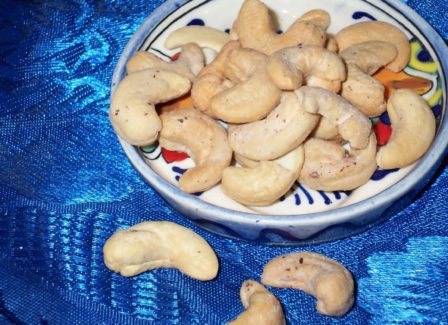Cashew Surprise
While nibbling on some mixed nuts, it occurred to me that I had never seen cashews in the shell anywhere in the market. I was curious about it, but did not follow through. Then, while reading an ingredient label on a skin care product, I saw a familiar-seeming botanical name, Ancacardium occidentale. Doing an internet search revealed the main ingredient in the cream came from the same plant as the cashew nut tree. But what part of the plant was used?
The cashew tree is common in dry, tropical areas, both as a wild and cultivated tree. It is used as a wind break, for erosion control, shade and as a local and commercial food source. The wood is used in furniture making and to create a long-burning, good quality charcoal. The gum that oozes from the fruit stems is collected and used as varnish that has the added benefit of repelling insects. The fruit is about the size and shape of a pear, with the seed as an external appendage, a little curlicue “tail” that sticks down from the base of the fruit. The fruit is prized for its refreshing juice and is fermented locally into popular beverages. The fruit does not keep well, so it is not shipped commercially. However, cashew trees are reported to grow in agricultural zone 10 (that is our zone), and could be cultivated here in San Diego, if you wanted to taste the ripe fruit for yourself.
The seed pod has a shell around the inner cashew nut. This hull/shell, when pressed, yields very potent, toxic oil that is so effective at repelling insects. It is prized in the tropics to treat termite infestations in buildings. That would explain why the seed does not come to our stores still in its shell. Cashew is part of a plant family that includes mango, pistachio and poison ivy and, as a family member, it shows traits from all three of its cousins by creating a palatable fruit, a tasty nut and a rash-inducing oil.
Oddly enough, it is this toxic oil that is prized in skin care products. It is anti-bacterial, anti-viral, and caustic. Cashew extract is used topically for its ability to remove warts, skin tags and other skin irregularities. It has even shown promise for treating HPV (human papillo virus) lesions. It take less than a drop of the oil applied to the mole or plantar’s wart to cause it to scab over and another week for the dead tissue to fall off. Care must be taken to confine the cashew oil or cream to the target area, as it will damage healthy skin, as well. It is a good thing that it is effective in small doses. Purchasing a tiny, 3ml bottle of the extract oil will cost $30 or more; a concentrated cream of .5 ml will set you back $60 and up, depending on the other ingredients included in the cream.
Due to the unique, spiral shape of the cashew nut and its hull, the nuts need to be separated by hand, making it labor-intensive to produce for commerce. With all of this information, I find myself marveling that we get to buy these delicious nuts at a fairly reasonable price. And now that I know of the medicinal uses, I am encouraged to try to grow this tree for my project in Balboa Park, the Trees for Health Garden. I found a source for seeds that are guaranteed to germinate. I wonder if the seeds will come in the hull and whether I will need to handle them with gloves in order to avoid damage to my hands. I think that it would be worth that trouble.
Category: Life Style








